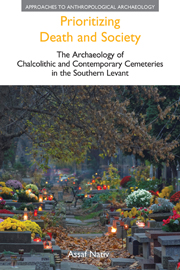 Prioritizing Death and Society
Prioritizing Death and Society from Part II - Chalcolithic cemeteries
As noted, cemeteries are often considered an innovation of the Chalcolithic period. Their novelty, however, does not pertain to the emergence of collective burial grounds per se, but to their specialization. Indeed, sites of repeated human burial are known from earlier periods, particularly the Natufian (e.g. Grosman et al. 2008; Nadel et al. 2009), and the Neolithic (e.g. Galili et al. 2009). However, their funerary function was commonly intertwined with quotidian and sometimes also cultic realms of conduct (cf. Grosman & Munro 2007; Rosen et al. 2007). Unlike these, the cemeteries of the Chalcolithic period suggest a greater degree of specialization: they are clearly demarcated in space, they are only minimally influenced by other fields of practice, and they are specifically designated for the interment of human remains.
Cemeteries, however, are but one aspect of a wide and diverse range of Chalcolithic funerary phenomena, both intra- and extra-mural. Consequently, the line of distinction between cemetery and non-cemetery is not always clear. For this purpose, two strict criteria are upheld in this study: first, the sites in question must be spatially and functionally distinct from habitation sites; and, second, there must be evidence for systematic and repeated interment of human remains. Thus, intra-mural mortuary contexts will not be considered here.
To save this book to your Kindle, first ensure [email protected] is added to your Approved Personal Document E-mail List under your Personal Document Settings on the Manage Your Content and Devices page of your Amazon account. Then enter the ‘name’ part of your Kindle email address below. Find out more about saving to your Kindle.
Note you can select to save to either the @free.kindle.com or @kindle.com variations. ‘@free.kindle.com’ emails are free but can only be saved to your device when it is connected to wi-fi. ‘@kindle.com’ emails can be delivered even when you are not connected to wi-fi, but note that service fees apply.
Find out more about the Kindle Personal Document Service.
To save content items to your account, please confirm that you agree to abide by our usage policies. If this is the first time you use this feature, you will be asked to authorise Cambridge Core to connect with your account. Find out more about saving content to Dropbox.
To save content items to your account, please confirm that you agree to abide by our usage policies. If this is the first time you use this feature, you will be asked to authorise Cambridge Core to connect with your account. Find out more about saving content to Google Drive.